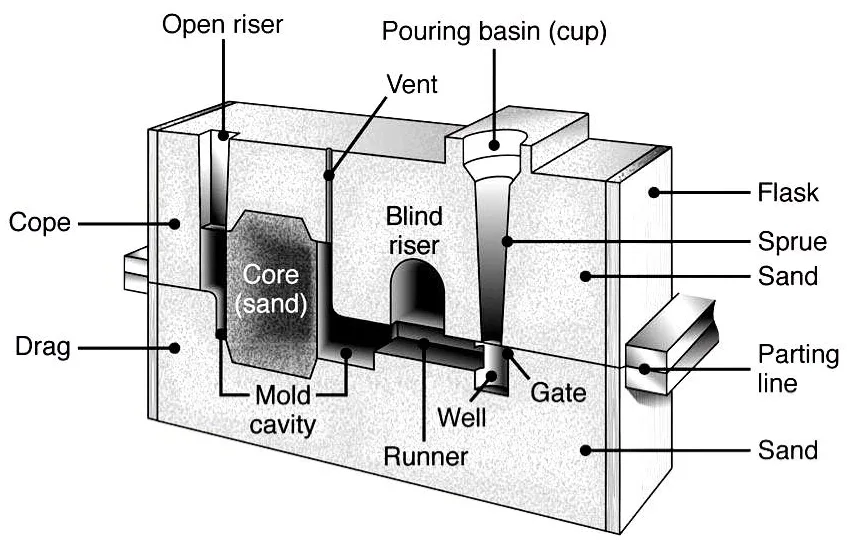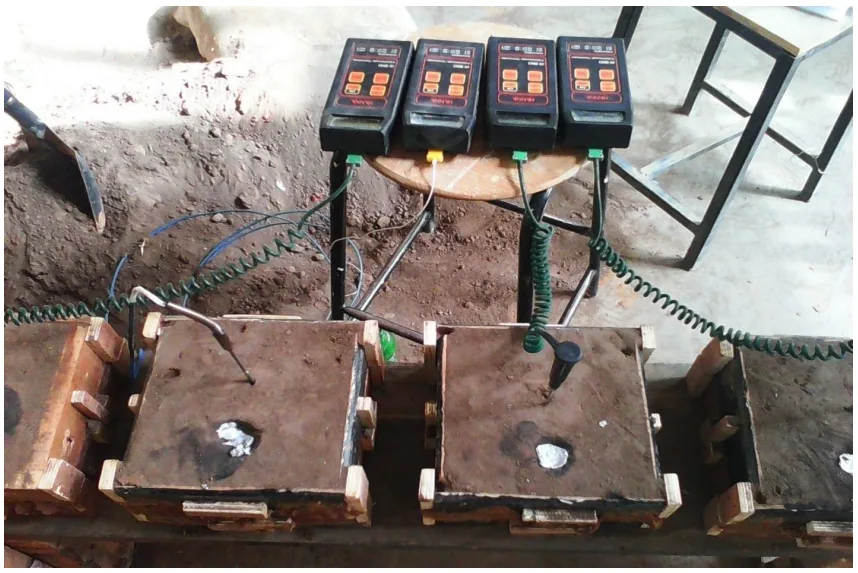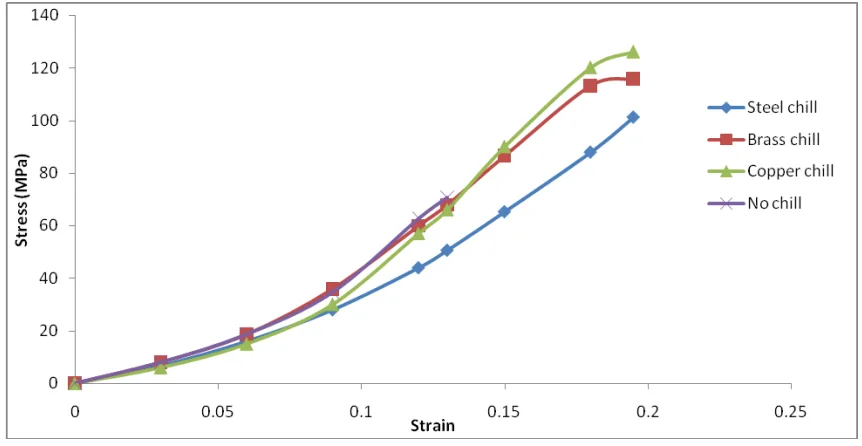This technical brief is based on the academic paper "PERFORMANCE EVALUATION OF DIFFERENT MATERIALS AS CHILLS IN SAND CASTING OF ALUMINIUM ALLOY" by Kabiru Muftau Raji, submitted to the School of Postgraduate Studies, Ahmadu Bello University Zaria (2016). It is summarized and analyzed for HPDC professionals by the experts at CASTMAN.

Keywords
- Primary Keyword: Sand casting aluminum alloy chills
- Secondary Keywords: Mechanical properties of aluminum alloy, solidification rate, chill material performance, copper chills, microstructure analysis, ultimate tensile strength in casting, brass chills
Executive Summary
- The Challenge: In the sand casting of aluminum alloys, slow and uncontrolled solidification often leads to a coarse grain structure, resulting in poor mechanical properties such as low tensile strength and hardness.
- The Method: The study evaluated the effect of different metallic chills (steel, brass, and copper) on the solidification and mechanical properties of a sand-cast aluminum alloy, comparing them against a sample cast without a chill.
- The Key Breakthrough: The aluminum alloy sample cast using copper chills demonstrated the highest mechanical properties, achieving an ultimate tensile strength of 126.13 MPa and a hardness of 6.87 Hv. This was a direct result of copper's superior thermal conductivity, which produced the fastest solidification rate and the finest microstructure.
- The Bottom Line: The choice of chill material is a critical factor that directly influences the final quality and performance of a cast aluminum component. This research provides clear data that using copper chills is a highly effective strategy for enhancing mechanical properties.
The Challenge: Why This Research Matters for HPDC Professionals
Achieving superior and consistent mechanical properties in aluminum alloy castings is a persistent challenge in the foundry industry. Normal solidification in a sand mold is often too slow, leading to the formation of an undesirable coarse grain structure and porosity. This microstructure compromises the casting's integrity, resulting in reduced hardness, lower tensile strength, and diminished impact resistance. For engineers and manufacturers in demanding sectors like automotive and aerospace, where component reliability is non-negotiable, overcoming these defects is paramount. The core problem investigated in this research is how to enhance the rate of heat removal during solidification to produce a finer, stronger microstructure and, consequently, a higher-quality final product.
The Approach: Unpacking the Methodology
To investigate the impact of different chill materials, the researcher conducted a controlled experiment. Four plates of an aluminum-silicon alloy were cast using sand molds. The experimental setup was as follows:
- One mold contained chills made of mild steel.
- A second mold contained chills made of brass.
- A third mold contained chills made of copper.
- A fourth mold, serving as the control, contained no chills.
The chills, cylindrical in shape (7mm diameter, 50mm length), were arranged at regular 30mm intervals within the molds. After casting, the samples underwent rigorous testing to evaluate their mechanical properties, including tensile strength, hardness, and impact strength. An optical metallurgical microscope was used for the metallographic analysis to examine the resulting microstructure of each sample. This comparative approach allowed for a direct evaluation of each chill material's effectiveness.
The Breakthrough: Key Findings & Data
The results of the study clearly demonstrate a strong correlation between the chill material, the solidification rate, and the final mechanical properties of the cast aluminum alloy.
- Finding 1: Copper Chills Drastically Increase Solidification Rate: The cooling curves showed that the sample with copper chills solidified significantly faster than all others. This is attributed to the high thermal conductivity and volumetric heat capacity of copper (Table 4.3). The brass chill provided the next fastest rate, while the steel chill offered only a marginal improvement over the unchilled sample (Figure 5.1).
- Finding 2: Superior Mechanical Properties with Copper: The sample chilled with copper exhibited the highest ultimate tensile strength (126.13 MPa) and hardness (6.87 Hv). In contrast, the unchilled sample showed the lowest values at 70.67 MPa and 4.2 Hv, respectively. The brass-chilled sample also performed well, surpassing the steel-chilled sample (Table 4.2).
- Finding 3: Finer Microstructure Formation: The rapid heat extraction from the copper chills resulted in a fine-grained, evenly distributed microstructure (Plate 3). As the cooling rate decreased with brass, steel, and no chill, the microstructure became progressively coarser (Plates 2, 1, and 4, respectively). This finer structure is key to the improved strength and hardness observed.
Practical Implications for Your HPDC Products
While this study was conducted in a sand casting environment, the fundamental principles of thermal management are directly applicable to High-Pressure Die Casting operations. The findings offer valuable insights for enhancing component quality.
- For Process Engineers: The findings in the "Conclusion" section suggest that strategically incorporating materials with high thermal conductivity, like copper alloys, into die designs can significantly increase local solidification rates. This could potentially reduce cycle times and improve mechanical properties like tensile strength and hardness.
- For Quality Control: The strong correlation shown between the cooling rate, microstructure (Plates 1-4), and mechanical properties (Table 4.2) provides a powerful reminder that thermal management is a critical process variable. Monitoring and controlling cooling is essential for achieving consistent, high-performance castings and reducing defect rates.
- For Die Design: This study on chill materials implies that die design choices regarding cooling channels and the use of inserts made from high-conductivity materials have a measurable impact on the final product's microstructure and performance. The data strongly supports using materials like copper to tackle challenging areas prone to defects like shrinkage porosity.
Paper Details
PERFORMANCE EVALUATION OF DIFFERENT MATERIALS AS CHILLS IN SAND CASTING OF ALUMINIUM ALLOY
1. Overview:
- Title: PERFORMANCE EVALUATION OF DIFFERENT MATERIALS AS CHILLS IN SAND CASTING OF ALUMINIUM ALLOY
- Author: KABIRU MUFTAU RAJI
- Year of publication: 2016
- Journal/academic society of publication: A Dissertation submitted to the School of Postgraduate Studies, Ahmadu Bello University Zaria, Nigeria.
- Keywords: Chill, sand casting, aluminium alloy, mechanical properties, microstructure, solidification
2. Abstract:
This study has evaluated the effectiveness of metallic materials as chill in sand casting of aluminium alloy. Four plates of dimension 165mm x 80mm x10mm were cast using sand mould. Steel, copper and brass chills in form of cylindrical bar of geometry 7mm in diameter and 50mm long were inserted, side by side at regular intervals of 30mm in each sand mould and the last sample was left unchilled. Experimentation involved testing of mechanical properties and metallographic analysis of cast samples. The results obtained revealed that the sample chilled with copper has the highest mechanical properties (ultimate tensile strength of 126.13MPa, hardness of 6.8Hv and impact strength of 23.5J).Also sample chilled with copper revealed evenly distributed microstructure which is due to the fast solidification rate of the casting due to the high thermal conductivity of copper. The brass chill sample displayed better mechanical properties (ultimate tensile strength of 115.8MPa, hardness of 5.7Hv and impact strength of 22.4J) than sample chilled with steel (ultimate tensile strength of 101.33MPa and hardness of 5.4Hv). However, the unchilled sample showed the lowest ultimate tensile strength of 70.67MPa, hardness of 4.2Hv and impact strength of 22.5J.
3. Introduction:
The paper introduces metal casting as a fundamental shaping process. It highlights that achieving good mechanical properties in sand casting of aluminum alloys is challenging without assistance. Chills, which are metallic inserts placed in the mold, are used to promote a high solidification rate and achieve desirable directional solidification. The research aims to address the problem of poor mechanical properties caused by the coarse grain structures that result from slow, natural solidification in sand molds.
4. Summary of the study:
Background of the research topic:
Aluminum alloys are widely used but can be difficult to cast effectively, as they freeze over a wide temperature range, making them susceptible to defects. Chills are used to create steep temperature gradients, promoting directional solidification and improving the soundness of the casting.
Status of previous research:
Previous studies have confirmed the benefits of chills, but this work specifically investigates the placement of different metallic chill materials at regular intervals to enhance solidification uniformly.
Purpose of the study:
The study's purpose was to evaluate and compare the effectiveness of copper, mild steel, and brass as chill materials in the sand casting of aluminum alloys. The objectives were to assess their impact on mechanical properties and microstructure and to establish a correlation between them.
Core study:
The core of the study involved casting four identical aluminum alloy plates under different chilling conditions (copper, brass, steel, and no chill) and then conducting a comparative analysis of their resulting mechanical and microstructural properties.
5. Research Methodology
Research Design:
An experimental design was used, comparing three test groups (steel, brass, copper chills) against a control group (no chill).
Data Collection and Analysis Methods:
Four aluminum alloy samples were cast. The chemical composition was determined using an Optical Emission Spectrometer. Mechanical properties were measured using a Hounsfield Tensometer (tensile strength), a Vicker Hardness tester, and a Charpy Impact Tester. Microstructural examination was performed with an Optical Metallurgical Microscope.
Research Topics and Scope:
The scope included the design of the sand molds with chills, casting the aluminum alloy, and evaluating the mechanical properties and microstructure of the cast samples to establish a structure-property correlation.
6. Key Results:
Key Results:
The study found that the sample chilled with copper had the highest solidification rate, which resulted in the best mechanical properties: ultimate tensile strength of 126.13 MPa, hardness of 6.87 Hv, and impact strength of 23.5 J. The brass-chilled sample was second best, followed by the steel-chilled sample. The unchilled sample had the poorest properties. The microstructure's grain size was finest with copper and coarsest in the unchilled sample, directly correlating with the mechanical test results.
Figure Name List:


- Figure 2.1: Production steps in a typical sand casting
- Figure 2.2: Schematic illustration of sand core
- Figure 2.3: Schematic illustration of a sand mould
- Figure 2.4: Shrinkage caused by progressive solidification
- Figure 3.1: Sand mould with chills
- Figure 3.2: Sand mould without chill
- Figure 3.3: Cast metal in sand mould with thermocouples
- Figure 3.4: Schematic illustration of the tensile test sample
- Figure 5.1: Cooling curves of aluminium alloy during solidification
- Figure 5.2: Graph of ultimate tensile strength of samples with different chill materials
- Figure 5.3: Graph of hardness value of samples with different chill materials
- Figure 5.4: Chart of impact strength of samples with different chill materials
- Figure A: Stress-strain curves of the aluminium alloy
7. Conclusion:
The study concludes that the cast aluminum alloy sample with a copper chill displayed the highest mechanical properties and the finest grain structure. The sample with a copper chill also solidified faster than any other sample. The coarseness of the grains in the microstructure increased progressively from the copper-chilled sample to the unchilled sample.
8. References:
- Chi-Yuan, C., Jun-Yen, U. and Te-Chang, T. (2006). Effect of cooling rate on Mg17Al12 volume fraction and compositional inhomogeneity in a sand-cast AZ91D magnesium plate. Materials Transaction, Japan Institute of Metals, 47(8), pp 2060-2067.
- Dobrzanski, L. A., Maniara, R. and Sokolowski, J. H. (2007). The effect of cooling rate on microstructure and mechanical properties of AC AlSi9Cu alloy. Achieves of Materials Science and Engineering Journal, 28, pp 105-112.
- Joel, H. (2001). Effect of chills on soundness and ultimate tensile strength (UTS) of aluminum alloy-corundum particulate composite. Journal of Materials and Design, 22, Published by Elsevier Science, pp 375-385.
- Zhang, L. Y., Jiang, Y. H., Ma Z., Shan, S. F. Jia, Y. Z., Fan, C. Z. and Wang, W. K. (2008). Effect of cooling rate on solidified microstructure and mechanical properties of aluminium-A356 alloy. Journal of Materials Processing Technology, 207, pp 107-111.
Expert Q&A: Your Top Questions Answered
Q1: What was the single most critical factor identified in this study for improving the mechanical properties of the cast aluminum alloy?
A1: The study concluded that the choice of chill material, which dictates the solidification rate, was the most critical factor. Copper was the most influential due to its high thermal conductivity and volumetric heat capacity. This is detailed in the "Conclusion" and supported by the data in Figure 5.1 and Table 4.3. (Source: "PERFORMANCE EVALUATION OF DIFFERENT MATERIALS AS CHILLS IN SAND CASTING OF ALUMINIUM ALLOY", Conclusion, Figure 5.1, Table 4.3).
Q2: How does this research compare to traditional methods for addressing poor mechanical properties?
A2: The paper's Statement of the Research Problem notes that normal solidification without chills results in poor mechanical properties due to coarse grain structures. This research introduces a comparative analysis of different chill materials, demonstrating that using copper chills is a superior method to significantly increase the solidification rate and improve mechanical properties over an unchilled casting. (Source: "PERFORMANCE EVALUATION OF DIFFERENT MATERIALS AS CHILLS IN SAND CASTING OF ALUMINIUM ALLOY", Statement of the Research Problem).
Q3: Is this finding applicable to all types of alloys, or a specific one?
A3: The research, as described in the Materials and Methodology section, was specifically conducted using an aluminum-silicon alloy from scrap, with its chemical composition detailed in Table 3.1. The applicability of these specific results to other alloys would require further investigation. (Source: "PERFORMANCE EVALUATION OF DIFFERENT MATERIALS AS CHILLS IN SAND CASTING OF ALUMINIUM ALLOY", Materials and Methodology, Table 3.1).
Q4: What specific measurement or simulation technique did the researchers use to arrive at this conclusion?
A4: The researchers utilized physical testing equipment, including a Hounsfield Tensometer for tensile strength, a Vicker Hardness tester for hardness, a Charpy Impact Tester for toughness, and an Optical Metallurgical Microscope for microstructural examination to quantify the results, as explained in the "Equipment" section (3.2). (Source: "PERFORMANCE EVALUATION OF DIFFERENT MATERIALS AS CHILLS IN SAND CASTING OF ALUMINIUM ALLOY", Equipment section 3.2).
Q5: According to the paper, what is the main limitation or area for future research?
A5: The authors state in the Recommendations section that future work should focus on investigating the influence of different chill sizes on solidification time and mechanical properties, as well as the potential effects of different cooling mediums or subsequent heat treatment. (Source: "PERFORMANCE EVALUATION OF DIFFERENT MATERIALS AS CHILLS IN SAND CASTING OF ALUMINIUM ALLOY", Recommendations section 6.3).
Q6: What is the direct, practical takeaway from this paper for a die casting facility?
A6: The core takeaway is that by optimizing the cooling rate, specifically by using a high-conductivity material like copper for chills or die inserts, it is possible to achieve superior mechanical properties and a finer grain structure in aluminum alloy castings, a conclusion strongly supported by the overall results of the paper, "PERFORMANCE EVALUATION OF DIFFERENT MATERIALS AS CHILLS IN SAND CASTING OF ALUMINIUM ALLOY".
Conclusion & Next Steps
This research provides a valuable roadmap for enhancing the quality and performance of aluminum alloy castings. The findings offer a clear, data-driven path toward improving mechanical properties, reducing defects, and optimizing production by carefully managing thermal conditions during solidification. The significant advantage conferred by copper chills is a key insight for any manufacturer looking to push the boundaries of component performance.
At CASTMAN, we are dedicated to applying the latest industry research to solve our customers' most challenging die casting problems. If the issues discussed in this paper resonate with your operational goals, contact our engineering team to discuss how we can help you implement these advanced principles in your components.
Copyright
- This material is a summary of a paper by "KABIRU MUFTAU RAJI". Based on "PERFORMANCE EVALUATION OF DIFFERENT MATERIALS AS CHILLS IN SAND CASTING OF ALUMINIUM ALLOY".
- Source of the paper: Dissertation, Ahmadu Bello University Zaria, Nigeria.
This material is for informational purposes only. Unauthorized commercial use is prohibited.
Copyright © 2025 CASTMAN. All rights reserved.